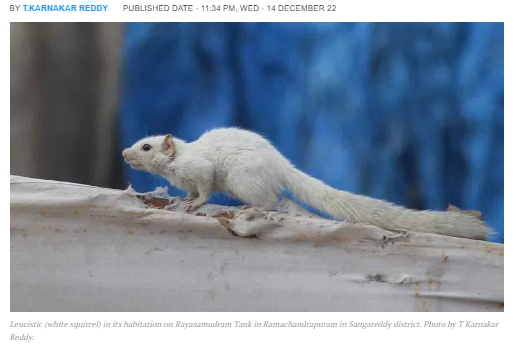First white squirrel in Telangana sighted at Rayasamudram Tank

Wildlife Biologist at Nehru Zoological Park Lakshman said leucisim was a rare condition in which there is a loss of pigmentation in an animal resulting in white, pale or patchy coloration of skin or hair.
Sangareddy: In what is said to be a very rare sighting in the country, a white squirrel, also called a leucistic squirrel, was spotted on the bund of the Rayasamudram tank in Ramachandrapuram of Sangareddy district. Officially, there is no documentation of a leucistic squirrel found in the State so far. The juvenile squirrel in Ramachandrapuram was seen playing on the trees with his mother and a sibling, both of whom were normal with three stripes in the regular gray-brown colour.
Wildlife Biologist at Nehru Zoological Park Lakshman said leucisim was a rare condition in which there is a loss of pigmentation in an animal resulting in white, pale or patchy coloration of skin or hair. Since the squirrel’s eyes are normal, Lakshman said it was not an Albino squirrel. The eyes of Albino animals are usually pink.
Leucistic animals have lower survival rates because they are easily detected by predators. Experts said leucism was relatively rare in small mammals like squirrels. The occurrence of leucism was attributed to different factors such as pollution, environmental alternations, low-quality diet and follicular damage.
“Researchers would be encouraged to report records of leucism in wildlife in order to better understand this phenomenon and the insights into the ecological and physiological implications of this condition, which has a significant effect on animal survival,” observed Arochikanathan Samson, Balasundaram Ramakrishnan and Subbaiah Bhargavi in their article on leucistic squirrels. These three researchers had first sighted the leucistic palm squirrel in South India in September 2016. They had spotted it in the Nilgiris in Tamil Nadu. The other two sightings were in Goa and Maharashtra by wildlife experts.







